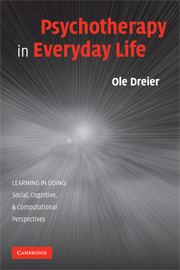Book contents
- Frontmatter
- Contents
- Series Foreword
- Preface
- Introduction
- 1 Re-Searching Psychotherapy as a Social Practice
- 2 Theorizing Persons in Structures of Social Practice
- 3 A Study – Its Design and Conduct
- 4 Clients' Ordinary Lives Plus Sessions
- 5 Therapy in Clients' Social Practice across Places
- 6 Changes in Clients' Practice across Places
- 7 Changing Problems across Places
- 8 The Conduct of Everyday Life and the Life Trajectory
- 9 The Children's Changing Conducts of Everyday Life and Life Trajectories
- 10 The Parents' Changing Conducts of Everyday Life and Life Trajectories
- 11 The Changing Conduct of Everyday Family Life and Family Trajectory
- 12 Research in Social Practice
- References
- Author Index
- Subject Index
- Learning in Doing: Social, Cognitive, and Computational Perspectives
5 - Therapy in Clients' Social Practice across Places
Published online by Cambridge University Press: 15 December 2009
- Frontmatter
- Contents
- Series Foreword
- Preface
- Introduction
- 1 Re-Searching Psychotherapy as a Social Practice
- 2 Theorizing Persons in Structures of Social Practice
- 3 A Study – Its Design and Conduct
- 4 Clients' Ordinary Lives Plus Sessions
- 5 Therapy in Clients' Social Practice across Places
- 6 Changes in Clients' Practice across Places
- 7 Changing Problems across Places
- 8 The Conduct of Everyday Life and the Life Trajectory
- 9 The Children's Changing Conducts of Everyday Life and Life Trajectories
- 10 The Parents' Changing Conducts of Everyday Life and Life Trajectories
- 11 The Changing Conduct of Everyday Family Life and Family Trajectory
- 12 Research in Social Practice
- References
- Author Index
- Subject Index
- Learning in Doing: Social, Cognitive, and Computational Perspectives
Summary
In the first two sections of this chapter, I go into the meaning of participating in sessions for clients on the basis of their participation in other contexts. In the last three sections I turn to how clients may link their participation and experiences in sessions into their social practice across places. The structural arrangement of sessions makes it necessary to understand how clients may accomplish this linking across places before going into the course of therapy-related changes in the next chapters. The fact that clients' participation and experiences in sessions and other places differ adds to its importance.
Diverse Modes of Participation in Diverse Contexts
As argued in chapter 1, research on therapy generally assumes that clients act in identical ways inside and outside sessions. That understanding is crucial to the prevailing idea about how sessions and clients' everyday lives are linked, how insights gained in sessions matter, and how therapy works. It also plays a key role in therapists' ideas about how a “good client” should behave. A good client hides nothing from her therapist and can be trusted to act in identical ways inside and outside sessions. In doing so, she allows her therapist comprehensive access and penetrating insight into her life from within sessions so that the therapist may reach a good understanding of his client on the basis of information obtained here. Therapists may, thus, assume to know from within sessions what their clients do outside sessions.
- Type
- Chapter
- Information
- Psychotherapy in Everyday Life , pp. 84 - 108Publisher: Cambridge University PressPrint publication year: 2007



